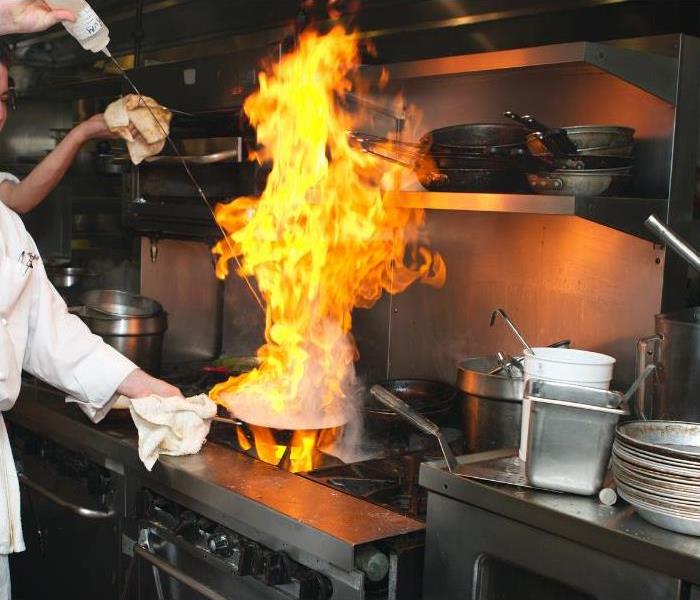What Should You Do to Reduce the Risk of a Commercial Kitchen Fire from your Cooking Systems?
11/29/2021 (Permalink)
Attention all restaurant and bar owners in North Atlanta & Buckhead: The National Fire Protection Association (NFPA) reports that fire departments responded to over 7,410 structure fires in the kitchen of restaurants and bars in 2017 alone. The majority of these fires were preventable, resulting in three deaths, 110 injuries, and $165 million in property damage annually in commercial kitchens. Not only do kitchen fires threaten the lives of staff and patrons, but they also put restaurants at risk of being shut down due to fire code violations when repairs are needed after a blaze.
What Are My Ducting and Air Movement Requirements to Prevent Fire?
While Chapter 7 of the NFPA 96 Standard for Ventilation Control and Fire Protection of Commercial Cooking Operations covers this extensively, here are a few key items to keep in mind.
First, commercial kitchen ducts should never pass through firewalls, share an exhaust system with the building ventilation, or have obstructed access panels. While doing these things on a commercial kitchen remodel can save costs in the short term, the fire risk increases significantly. If disregarded, your commercial kitchen work will likely not pass inspection.
Make sure to maintain a minimum clearance of 18 inches between combustible materials and the kitchen ducts. This standard is based on Section 4.2 of the NFPA 96, however is one of the easiest to disregard once the kitchen is operational. Ducts can build up high levels of radiant heat that can ignite combustible materials like boxes, cups, plates, utensils, or other kitchen materials.
If you would like additional information on the types of combustible and non-combustible materials that should and shouldn't be kept near the duct, consult Chapter 3 of the NFPA.
What Are My Commercial Kitchen Fire Extinguisher Requirements?
"The NFPA 96 requires automated fire suppression equipment for all grease removal devices, hood exhaust plenums, and exhaust duct systems in a commercial kitchen, as well as any cooking equipment that produces grease-laden vapors." - Koorsen Fire & Security
The NFPA 96 requires use of class K fire extinguishers in conjunction with automatic fire extinguishing systems. These extinguishers also require installed placards stating their extinguisher class. However, in the case of a commercial kitchen fire, it's critical to activate the automatic fire extinguisher system before using portable-type extinguishers. This is because high-efficiency cooking appliances in many modern commercial kitchens are capable of achieving high temperatures that can raise the vegetable oils to intensely high temperatures. When oil ignites at these high temperatures, it can already be so hot that a portable extinguisher is not enough to stop the flames.
Another standard that you should familiarize yourself with is the UL 300 standard.
According to this article by Insureon, a kitchen’s cooking equipment must meet these UL 300 requirements:
- Fire-extinguishing nozzles in the hood, ducts, and above each cooking appliance
- An automatic fuel shut-off capabilities for both gas and electric power sources
- A manual fuel shut-off pull for all power sources
- A wet-chemical fire-extinguishing system that meets UL 300 criteria (one of which is undergoing semiannual checkups by a certified professional)
Practice Proper Maintenance & Inspection in Your Commercial Facility
The first step towards proper maintenance to prevent a commercial kitchen fire in your facility is to create a regular plan for inspections. While you can do these yourself, it is often a good idea to consider outsourcing this service to a proper NICET Certified Fire Inspector. Depending on the volume of cooking in your commercial kitchen, they will likely recommend monthly, quarterly, or annual inspections to ensure compliance and safety.
On regular inspections, fire inspectors will provide the best guidance on where you should focus your team's routine maintenance time and resources. Ultimately, it is up to you as an owner or manager on how closely you implement those recommendations.
Typically, at least the vent, hood, and duct must be cleaned regularly to remove grease vapor and prevent combustible material build-up. Grease Filters should be cleaned at least once per week, and your automatic fire suppression system should be inspected at least every 6 months or as required by your local regulations. Regular cleaning according to equipment specifications should be observed as well.
What To Do If There Is a Fire In My Commercial Kitchen?
If you can, get everyone out safely. If you have an outdoor exit, have people leave that way. Do not open any interior doors or windows or use elevators during a fire. Even if it seems like it’s far away, do not stop to pick up personal belongings. Unless it’s your home, never go back inside during or after a fire. Once you are safe, call 911 immediately and stay on the line until help arrives. Once firefighters arrive on the scene they will assess if there is still a risk for injury within any structure fires before allowing you to re-enter your building.
Next, you should call a fire restoration expert like SERVPRO of North Atlanta to help you quickly restore your commercial kitchen to an operational state.
Our trained technicians are available 24/7/365, and ready to help. We also offer a special Emergency Response Plan to commercial facilities to reduce property damage in the case of an emergency commercial fire event. Call us today at (404) 261-2925 for emergency services or to schedule your free SERVPRO ERP.




 24/7 Emergency Service
24/7 Emergency Service
